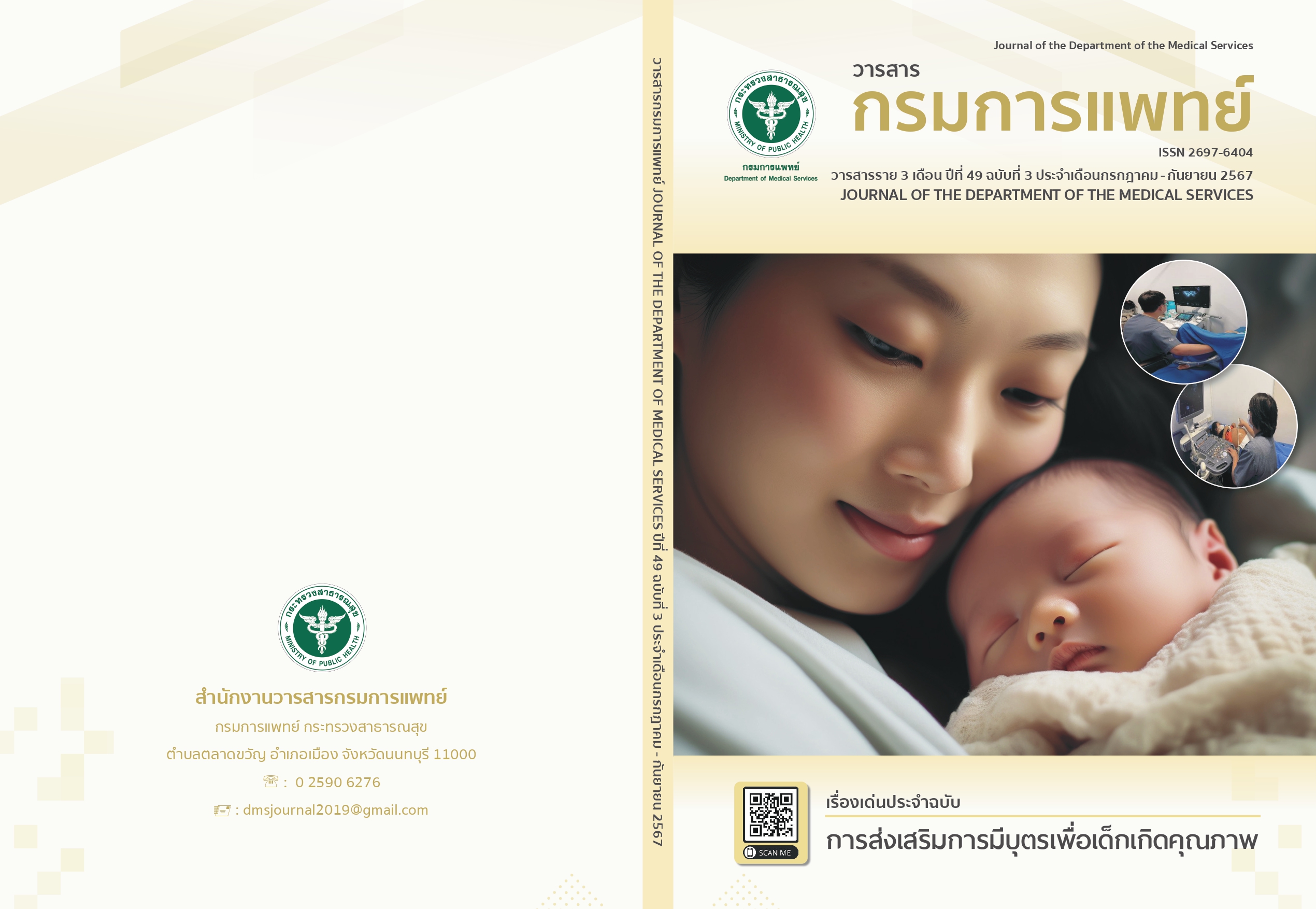The Results of Using Denosumab in Patients with Osteoporosis at Samut Sakhon Hospital over a Period of 2 Years
Keywords:
Denosumab, Osteoporosis, BMD of Spine, BMD of Hip, eGFRAbstract
Background: After the continuous administration of 60 mg, denosumab subcutaneously every 6 months in patients diagnosed with osteoporosis, it was observed that some patients experienced a decrease in kidney function, and in some cases, hip fractures occurred while receiving denosumab. Objective: To study the effects of denosumab on the lumbar spine, hip bones, and kidney function in osteoporosis patients. Method: This research was retrospective study. Result: 70 cases were studied. It was found that after patients received 60 mg denosumab injections subcutaneously every 6 months for a period of 2 years, bone mineral density and T-score of the lumbar spine significantly improved (p < .05). The bone mineral density of the lumbar spine at L1, L2, L3, L4, and L1-4, increased by 6.10%, 7.77%, 7.02%, 6.40%, and 7.55%, respectively. However, the bone mineral density and T-score of the hip did not change. There was a significant decrease in kidney function (p<0.05) from the initial average value of 72.34 to 67.08, an average of reduction was 7.27%. The decrease in kidney function was associated with age of the patients (p = .020), patients with diabetes (p = .011), hypertension (p < .001), collapsed spines (p = .046) and hip fracture (p = .002) diagnosed before treatment. Conclusion: Caution should be exercised in the use of denosumab, especially in patients with underlying risk factors as mentioned. BMD of hip did not change after 2 years of treatment but BMD of spines statistical significantly increased.
References
Porter JK, Varacallo M. Osteoporosis. StatPearls [Internet]. 2022 [cited 2023 Jul 1]. Available from: https://www.ncbi.nlm.nih.gov/books/NBK441901/.
Sathira-Angkura V, Piyaskulkaew C, Sumanasrethakul C, Kanchanatawan W, Prutikul P. Osteoporosis. In Choosna Makarasara. Thailand Medical Services Profile 2011-2014 First Edition. Nonthaburi: Department of medical service; 2014. p.17/1-9.
Institute for Population and Social Research, Mahidol University. [Internet]. From 50 million population to the highest level of aging society. [cited 2023 Aug 11]. Available from: https://ipsr.mahidol.ac.th/ipsrbeta/FileUpload/PDF/Report-File-665.pdf
Thai Osteoporosis Foundation. Clinical Practice Guideline for treatment of Osteoporosis. Bangkok: Thai Osteoporosis Foundation; 2021.
Miller PD, Bolognese MA, Lewiecki EM, McClung MR, Ding B, Austin M, et al. Effect of denosumab on bone density and turnover in postmenopausal women with low bone mass after long-term continued, discontinued, and restarting of therapy: a randomized blinded phase 2 clinical trial. Bone 2008;43(2):222-9.
Bone HG, Bolognese MA, Yuen CK, Kendler DL, Miller PD, Yang YC, et al. Effects of denosumab treatment and discontinuation on bone mineral density and bone turnover markers in postmenopausal women with low bone mass. J Clin Endocrinol Metab 2011;96(4):972-80.
Cummings SR, San Martin J, McClung MR, Siris ES, Eastell R, Reid IR, et al. Denosumab for prevention of fractures in postmenopausal women with osteoporosis. N Engl J Med 2009;361(8):756-65.
Bone HG, Wagman RB, Brandi ML, Brown JP, Chapurlat R, Cummings SR, et al. 10 years of denosumab treatment in postmenopausal women with osteoporosis: results from the phase 3 randomised FREEDOM trial and open-label extension. Lancet Diabetes Endocrinol 2017;5(7):513-23.
Ohishi T, Fujita T, Nishida T, Hagiwara K, Murai R, Matsuyama Y. Effect of denosumab on renal function in women with osteoporosis evaluated using cystatin C. Osteoporos Sarcopenia 2022;8(2):68-74.
Broadwell A, Chines A, Ebeling PR, Franek E, Huang S, Smith S, et al. Denosumab safety and efficacy among participants in the FREEDOM extension study with mild to moderate chronic kidney disease. J Clin Endocrinol Metab 2021;16:397-409.
Downloads
Published
How to Cite
Issue
Section
License
Copyright (c) 2024 Department of Medical Services, Ministry of Public Health

This work is licensed under a Creative Commons Attribution-NonCommercial-NoDerivatives 4.0 International License.
บทความที่ได้รับการตีพิมพ์เป็นลิขสิทธิ์ของกรมการแพทย์ กระทรวงสาธารณสุข
ข้อความและข้อคิดเห็นต่างๆ เป็นของผู้เขียนบทความ ไม่ใช่ความเห็นของกองบรรณาธิการหรือของวารสารกรมการแพทย์



